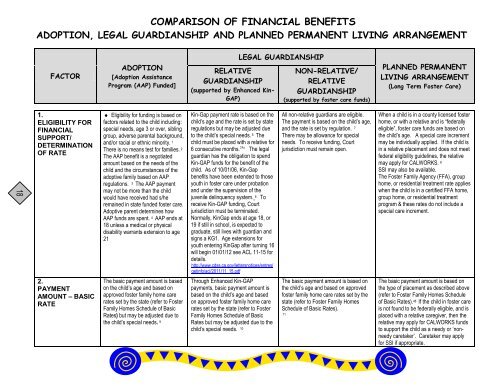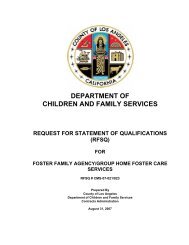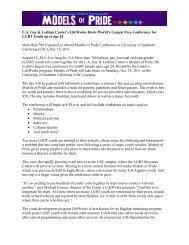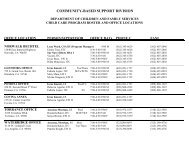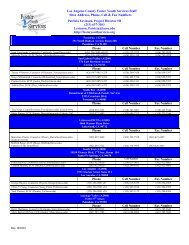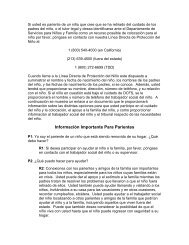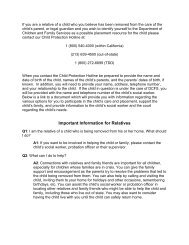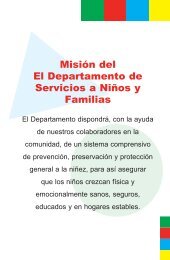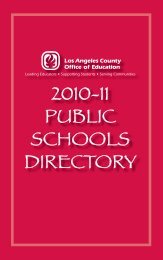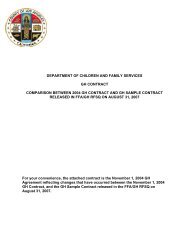Permanency Guide - Los Angeles County Department of Children ...
Permanency Guide - Los Angeles County Department of Children ...
Permanency Guide - Los Angeles County Department of Children ...
You also want an ePaper? Increase the reach of your titles
YUMPU automatically turns print PDFs into web optimized ePapers that Google loves.
COMPARISON OF FINANCIAL BENEFITS<br />
ADOPTION, LEGAL GUARDIANSHIP AND PLANNED PERMANENT LIVING ARRANGEMENT<br />
FACTOR<br />
1.<br />
ELIGIBILITY FOR<br />
FINANCIAL<br />
SUPPORT/<br />
DETERMINATION<br />
OF RATE<br />
2.<br />
PAYMENT<br />
AMOUNT – BASIC<br />
RATE<br />
ADOPTION<br />
[Adoption Assistance<br />
Program (AAP) Funded]<br />
♦ Eligibility for funding is based on<br />
factors related to the child including:<br />
special needs, age 3 or over, sibling<br />
group, adverse parental background,<br />
and/or racial or ethnic minority. 1<br />
There is no means test for families. 2<br />
The AAP benefit is a negotiated<br />
amount based on the needs <strong>of</strong> the<br />
child and the circumstances <strong>of</strong> the<br />
adoptive family based on AAP<br />
regulations. 3 The AAP payment<br />
may not be more than the child<br />
would have received had s/he<br />
remained in state funded foster care.<br />
Adoptive parent determines how<br />
AAP funds are spent. 4 AAP ends at<br />
18 unless a medical or physical<br />
disability warrants extension to age<br />
21<br />
The basic payment amount is based<br />
on the child’s age and based on<br />
approved foster family home care<br />
rates set by the state (refer to Foster<br />
Family Homes Schedule <strong>of</strong> Basic<br />
Rates) but may be adjusted due to<br />
the child’s special needs. 9<br />
RELATIVE<br />
GUARDIANSHIP<br />
(supported by Enhanced Kin-<br />
GAP)<br />
Kin-Gap payment rate is based on the<br />
child’s age and the rate is set by state<br />
regulations but may be adjusted due<br />
to the child’s special needs. 5 The<br />
child must be placed with a relative for<br />
6 consecutive months. 24a The legal<br />
guardian has the obligation to spend<br />
Kin-GAP funds for the benefit <strong>of</strong> the<br />
child. As <strong>of</strong> 10/01/06, Kin-Gap<br />
benefits have been extended to those<br />
youth in foster care under probation<br />
and under the supervision <strong>of</strong> the<br />
juvenile delinquency system. 6 To<br />
receive Kin-GAP funding, Court<br />
jurisdiction must be terminated.<br />
Normally, KinGap ends at age 18, or<br />
19 if still in school, is expected to<br />
graduate, still lives with guardian and<br />
signs a KG1. Age extensions for<br />
youth entering KinGap after turning 16<br />
will begin 01/01/12 see ACL 11-15 for<br />
details.<br />
http://www.cdss.ca.gov/lettersnotices/entres/<br />
getinfo/acl/2011/11_15.pdf<br />
Through Enhanced Kin-GAP<br />
payments, basic payment amount is<br />
based on the child’s age and based<br />
on approved foster family home care<br />
rates set by the state (refer to Foster<br />
Family Homes Schedule <strong>of</strong> Basic<br />
Rates but may be adjusted due to the<br />
child’s special needs. 10<br />
LEGAL GUARDIANSHIP<br />
NON-RELATIVE/<br />
RELATIVE<br />
GUARDIANSHIP<br />
(supported by foster care funds)<br />
All non-relative guardians are eligible.<br />
The payment is based on the child’s age,<br />
and the rate is set by regulation. 7<br />
There may be allowance for special<br />
needs. To receive funding, Court<br />
jurisdiction must remain open.<br />
The basic payment amount is based on<br />
the child’s age and based on approved<br />
foster family home care rates set by the<br />
state (refer to Foster Family Homes<br />
Schedule <strong>of</strong> Basic Rates).<br />
11<br />
PLANNED PERMANENT<br />
LIVING ARRANGEMENT<br />
(Long Term Foster Care)<br />
When a child is in a county licensed foster<br />
home, or with a relative and is “federally<br />
eligible”, foster care funds are based on<br />
the child’s age. A special care increment<br />
may be individually applied. If the child is<br />
in a relative placement and does not meet<br />
federal eligibility guidelines, the relative<br />
may apply for CALWORKS. 8<br />
SSI may also be available.<br />
The Foster Family Agency (FFA), group<br />
home, or residential treatment rate applies<br />
when the child is in a certified FFA home,<br />
group home, or residential treatment<br />
program & these rates do not include a<br />
special care increment.<br />
The basic payment amount is based on<br />
the type <strong>of</strong> placement as described above<br />
(refer to Foster Family Homes Schedule<br />
<strong>of</strong> Basic Rates). 48 If the child in foster care<br />
is not found to be federally eligible, and is<br />
placed with a relative caregiver, then the<br />
relative may apply for CALWORKS funds<br />
to support the child as a needy or ‘nonneedy<br />
caretaker’. Caretaker may apply<br />
for SSI if appropriate.


